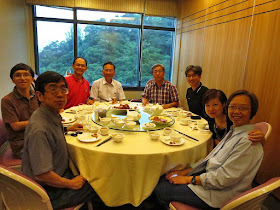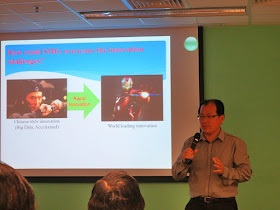The Executive Study Group (ESG) seminar Topic in August named “Crisis Management on Social Media – How to Handle Online Complaints Properly to Protect Brands” was held by the ESG, Asia Pacific Institute for Strategy Limited (APIFS) and the Hong Kong Science and Technology Parks Corp (HKSTPC) on 21 Aug 2015 in Grand Hall at Phase III. I would like to summarize the seminar for sharing below.

In the beginning, Dr. Mark Lee briefed the purpose of Executive Study Group (ESG) and he quoted Prof. Peter Drucker (Father of Management) that “Because the purpose of business is to create a customer, the business enterprise has two and only two basic functions: Marketing and Innovation.” And then he also quoted Jack Trout (Author of Best Seller – The 22 Immutable Laws of Marketing) that “Today, when top management is surveyed, their priorities in order are: Finance, Sales, Production, Management, Legal and People. Marketing and Innovation are missing from the list.” Then Dr. Mark Lee briefed the content of seminar included "The Revenge via Social Media”, “Double-Deviation Avoidance”, “Divide-and-Conquer Strategy for Complaints”, “Crisis Monitoring and Related Tools”, “How to Manage the Five Social Media Complaints” and “A New Form of Teamwork”, as well as, “Group Discussion”.
The Revenge via Social Media:The first case was a video in YouTube named “FedEx Guy Throwing My Computer Monitor”. Because of FedEx misbehavior of delivery, the owner posted this surveillance video into the YouTube. Even though FedEx created an adequate response within 3 Days via the company blog, it was too late that the video had already been viewed over half a million times in 2011. Until now (2015), there were still viral with over 9 million views (actual number is 9,545,461 on 21 Aug 2015).
Dr. Lee said that high cost of complaints in the Past but it was easier and more effective on Social Media. Customer had bargaining power through Publicity!
Double-Deviation Avoidance:
Double-Deviation occurs when customer complaints followed an initiation and propagation couplet. That is, a problem only becomes a problem when customers are not adequately compensated (fail recovery) for the initial mistake (fail), or when a second mistake occurs.
Divide-and-Conquer Strategy for Complaints:There are five types of social media complaint and could be classified as follows:
1. Directness: Directly contacting the company online
2. Boasting: Positive publicity about extraordinary service recovery
3. Badmouthing: Negative word-of-mouth “without” contacting the firm
4. Tattling: Complaining to a third party for help
5. Spite: Spreading negative publicity to get revenge
For 1st type “Directness” (Positive / Good Type)The first case quoted still FedEx. They established FedEx Customer Care Facebook page and used FedEx’s Redirection Strategy. In their Facebook page added “Contact Us – Email Customer Service (preferred): FacebookCS@fedex.com”.
The second case quoted Children’s Place. Their girl T-shirt design assumed girl bad in Math. Then they received complaint through Social Media. Children’s Place tweeted its apologyies at the same day and using the following steps to solve it.
Step 1 – Private Addressing: They had sending a new, different t-shirt, along with a box full of goodies.
Step 2 – Public Announcement: They addressed the public concern by announcing that the controversial t-shirt had been pulled from its stores.
Managing the 1st type of complaint strategy:
We need to recovery for an initial service failure which is Time Sensitive. For instance, the first answer minimally acknowledges the situation and difficulties encountered by the customer within 15 minutes. (One hour is reason) Then it will not trigger Double Deviation. Remember to respond publicly for simple case but respond privately for complex case and then remember to announce it is resolved!
For 2nd type “Boasting” (Positive / Good Type)The case for second type of social media complaint was Morrison’s Supermarket. The customer complaint was waiting too long to get bread sliced within 18 hours. Morrison’s Supermarket not only contacted the customer to apologize but also rearranged the bread racking so that employees could better view waiting customers. In Morrison tweeter communication, they contacted customer used the statement “Could you please DM us your telephone number so we can get in touch?”
Managing the 2nd type of complaint strategy:The case shared was Ritz-Carlton. A little boy left behind Joshie (stuffed giraffe) in the hotel. His father told him that Joshie decided to stay a few more days at the resort making friends and enjoying the sun. Then the father shared this white lie with the Ritz-Carlton staff and then they took a series of photos with Joshie to realize the father’s story. This father was a successful CEO (Chris Hurn) and influential blogger for the Huffington Post. After Chris’ blog post ran, this story became extremely popular on social media and in the business press.
For 3rd type “Badmouthing” (Negative / Bad Type)
Many social media shared mainly in photos. A picture is worth a thousand words such as picture of suitcase’s broken handle by Delta Airline on Instagram. Another case was British Airways. The customer used the paid “Promoted Tweet” to connect with the right audience to complain about his lost luggage. His tweet simply stated “Don’t fly@BritishAirways” and “Retweeting your British Airways complaints to show what a terrible airline they are, offering bad customer service, no communication and often losing your bags!” The post garnered over 25,000 impressions on Twitter in 6 hours!
Managing the 3rd type of complaint strategy:This type of customer is no interest in compensation and the company is no chance to fix the problem. However, the company could communicate its proactive competency and sense of caring. The following steps should be performed:
- Should publicly contact the individual to acknowledge the situation
- Invite him/her to engage in a private discussion
- Politely communicate and Acknowledgment Post
- Post the results to the Public (for public opinion)
For 4th type “Tattling” (Negative / Bad Type)Another case employed “Complaint Resolution Platform” such as PeopleClaim. However, this type of complaint was still motivated by reparation rather than revenge said by Dr. Lee. He added “Publicity” is the treat to your counterpart in this game.”
Managing the 4th type of complaint strategy:
If the third-party involvement happened, customers should strong cases because of filtered by the third-party. However, the third-party should be neutrality. Even an imperfect deal is better than facing a serious case of online revenge.
For 5th type “Spite” (Negative / Ugly Type)The worst case quoted United Airline. The singer’s guitar was broken by United Airline staff during transportation. This singer created a song named “United Breaks Guitars” and posted this video to YouTube on 6 July 2009. There are 150,000 views within one day. The video then garnered over half million hits by 9 July 2009. Unit Aug 2015, there has over 15 million hits. In Dec 2009, Time magazine named “United Breaks Guitars” No. 7 on its list of the Top 10 Viral Videos of 2009.
Managing the 5th type of complaint strategy:Damage control is KEY. It is difficult to control after viral. So company need to ensure no Double Deviation and focus on “Damage Control”. So quickly identify the threat through its monitoring systems and publicly acknowledge the situation on time.
In this “United Breaks Guitars” case, Mr. Robert Bradford (Managing Director, Customer Contact Centers, United Airlines) used this video for internal training and to change its customer service policy accordingly. Even though the customer didn’t accept the offered compensation US$3000, they donated to the Thelonious Monk Institute of Jazz as a “gesture of goodwill”. (See Singer's revenge on United: A hit song)
Crisis Monitoring and Related Tools:Dr. Lee said there are overall strategies to handle all types of complaints. Firstly, we need matching type of social media complaint with right manner and the effective monitoring was fundamental. He introduced three tools included “Google Alerts”, “TweetDeck” and “Social Mention”. He added the company needed sufficient investment of time and resources such as JetBlue employed 11 full-time staff to online monitoring on Twitter.
Lastly, Dr. Lee suggested that Customer Service and Public Relations departments worked together to address online complaints using the above management approach.
Before the Group Discussion, Dr. Lee gave us an exercise to find out two most difficult strategiesto be managed online complaints and selected the easiest one to be managed.
Reference:HKSTP -
www.hkstp.org Asia Pacific Institute for Strategy Limited (亞太策略研究所有限公司) –
www.apifs.org FedEx Guy Throwing My Computer Monitor -
https://www.youtube.com/watch?v=PKUDTPbDhnA United Breaks Guitars -
https://www.youtube.com/watch?v=5YGc4zOqozo Singer's revenge on United: A hit song -
http://www.upi.com/Odd_News/2009/07/09/Singers-revenge-on-United-A-hit-song/UPI-79301247160917/


















































